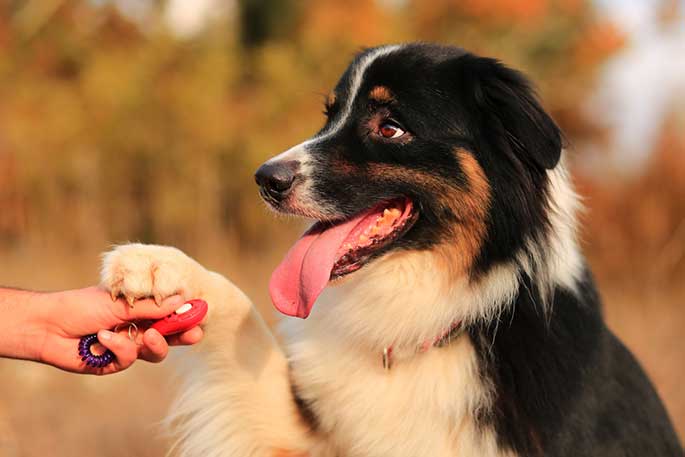
One of the most challenging parts of having a dog is training them to behave the way you want them to in any given circumstance. Many people use what’s called clicker training to help speed up this process of training.

What is clicker training for dogs? And how can we incorporate it into our training process? Read below to learn more about how clicker training can help speed up training your dog.
Read More:
- 5 Basic Must-Haves for Training Your Dog
- How Can You Teach Your Dog To Talk
- Train Your Dog To Be A Trick Master
- 5 Tips for Taking Care of Your New Puppy
What is Clicker Training for Dogs?
Clicker training is a method of training that uses a click to tell your dog when they’ve done something right. Most trainers will use a store-bought device called a clicker. This device is simply a plastic piece with a button. Pressing the button is what makes the click sound.
Clickers make a unique sound that is not usually made in daily life. Because the clicker makes such a unique sound, it is straightforward to train your dog to listen to it. Clicker training isn’t anything new, either. It has been used to teach all sorts of animals for years.
What Does a Click Mean?
Each click is a very distinct sound. It is a sharp sound, but for the most part, it is not harsh. If you are going to use a clicker to train your dog, it’s essential to teach them what a click means. Each click tells your dog they did something right. It also means that your dog can expect a reward for doing something right.
Most clickers can be attached to the wrist with a bracelet, so it can always be close at hand. Many trainers also chose to say the word “good” or “yes” when they click the button. This way, the dog will associate the word and the click with a reward. This can help at times when you don’t have the clicker with you.
How Does Clicker Training Help?
The benefit of clicker training is that the sound of a click is so distinct and immediate. Because of this, your dog will be able to distinguish it even if other noises are going on around you. That’s all a clicker is used for.
Once you “charge” the clicker, your dog will be able to associate the click with the reward and will better learn what you want them to do. Charge the clicker by clicking the button and then rewarding them with a tasty treat. The treat always follows the click. You should never give them a treat and click the button at the same time. Once your dog knows that a treat follows a click, they will pay close attention to you when you press the button. This will help you teach your dog new tricks, even if you do not have a direct line of sight with your dog.
Clicker Rules
When you decide to help train your dog by using a clicker, be sure to adhere to these easy rules:
- Only click the clicker once.
- If you click the button, you must give your dog a treat.
- Use the clicker to teach your dog something new or reinforce good behavior.
- Do not “aim” the clicker at your dog. It’s not like a remote control for the TV. Hold the clicker either at your side or behind your back.
- If your dog seems afraid of the clicker, muffle the sound with a towel or buy a softer clicker. If your dog doesn’t get used to the clicker, you should consider an alternative form of training.
These simple rules can help your clicker training be a success. As always, remember that training your dog will only work if you stick with it. If you only give it half your effort, it may work, but it will likely take twice as long to hold. Work with your dog every day, and you’ll be rewarded with an obedient dog.
How to Use Clicker Training?
Once you get your dog to understand the clicker’s role, you might be wondering what you can use the clicker to do. You can get your dog to do almost anything with the clicker. Remember, the clicker isn’t the motivating tool. It’s a tool to tell your dog when they’ve done something right immediately. As long as you’re catching your dog doing good things, the clicker can reinforce that behavior.
Say you wanted to teach your dog to sit. Watch your dog. Once their bottom hits the floor, click the clicker and immediately give them a treat. Next, when you catch them about to sit, say the command “sit” then click and treat them. This will have your dog associate the command “sit” with the action of sitting. Soon enough, your dog will understand that when you say sit, they should put their bottom to the ground.
The clicker and treats are what will teach your dog the expected behavior. Does that mean that you’ll have to treat your dog each time they sit on command? Actually, no. Clicker training is intended to speed up training your dog. Like with other forms of training, you can slowly remove the reward as your dog learns what to do. First, you remove every third or fourth treat. Then you remove every other treat. Soon enough, your dog will be willing to sit on command without the need for a treat.
Limitations to Clicker Training
While there aren’t many downsides to clicker training, we want to make you aware of its limitations. First, clicker training is reward-based, so if your dog isn’t interested in food or toys, this might not be the ideal training method. Second, if your dog isn’t appropriately trained or transitioned off constant reward-based reinforcement, your dog may lose the behaviors you worked so hard to teach them. Lastly, clicker training can be challenging for the trainer. It requires your attention and consistency. However, once you master the rules and follow through, you and your dog will be better for the experience.
Popular Post:



